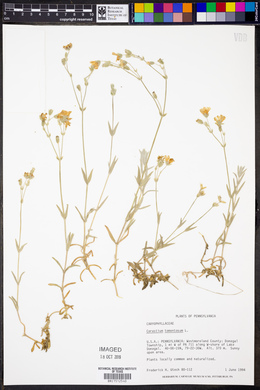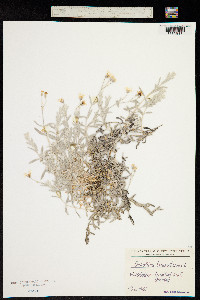Cerastium tomentosum
|
|
|
|
Family: Caryophyllaceae
Snow-in-Summer
[Cerastium repens L.] |
Plants perennial, mat-forming, rhizomatous. Stems: flowering stems ascending, branched, 15-40 cm; nonflowering stems prostrate proximally, rooting readily, pu-bescence dense, white-tomentose, eglandular; small axillary tufts of leaves often present. Leaves not marcescent, sessile; blade linear to linear-lanceolate or linear-oblong, 10-60 × 2-8 mm, apex ± obtuse, pubescence dense, whitish-tomentose, eglandular on both surfaces. Inflorescences lax, 3-13-flowered cymes; bracts lanceolate, margins scarious, pubescent. Pedicels ascending, straight, 10-40 mm, 2-7 times as long as sepals, white-tomentose. Flowers 12-20 mm diam.; sepals narrowly lanceolate-elliptic, 5-7 mm, margins narrow, often scarious, apex acute, white-tomentose; petals obtriangular, 10-18 mm, 2-2.5 times as long as sepals, apex 2-fid; stamens 10; styles 5. Capsules cylindric, slightly curved, 10-15 mm, 1.5-2 times as long as sepals; teeth 10, erect, margins convolute. Seeds brown, ca. 1.5 mm, round tubercles on margins, faces shallowly rugose; testa not inflated. 2n = 72. Flowering spring. A commonly grown rock-garden and wall plant, often escaping onto roadsides, riverbanks, old fields; 0-400 m; introduced; B.C., Man., N.B., Nfld. and Labr. (Nfld.), N.S., Ont., P.E.I., Que.; Maine, Mich., Mont., Nebr., N.Y., N.C., Ohio, Oreg., Pa., Wash., Wis., Wyo.; se Europe. Cerastium tomentosum hybridizes readily with the introduced C. arvense subsp. arvense (J. K. Morton 1973). North American reports of Cerastium biebersteinii de Candolle all appear to be referable to C. tomentosum. The two species are very similar, but C. biebersteinii has flat capsule teeth and is diploid (2n = 36); see M. K. Khalaf and C. A. Stace (2001).
Perennial herb with a rhizome, mat-forming 15 - 40 cm tall Leaves: opposite, stalkless, 1 - 6 cm long, 2 - 8 mm wide, linear to lance-shaped to linear-oblong with a more or less blunt tip, densely hairy with matted hairs (tomentose). Inflorescence: a lax cluster (cyme) of three to thirteen flowers subtended by hairy, lance-shaped bracts. Bracts scarious-margined (dry, thin, and membranous). Flowers: white, 1 - 2 cm in diameter. Stalk ascending, straight, 1 - 4 cm long, with matted hairs (tomentose). Stamens ten. Styles five. Sepals: five, distinct, 5 - 7 mm long, narrowly lance-shaped to elliptic, with matted hairs (tomentose). Petals: five, white, 1 - 1.8 cm long (two to two and a half times as long as the sepals), reverse triangular, two-lobed, clawed. Fruit: a dehiscent capsule (opening by ten short, upright teeth), 1 - 1.5 cm long, longer than the sepals, cylindrical, more or less curved. Seeds numerous, brown, egg- to kidney-shaped, dorsally grooved. Stems: prostrate (non-flowering) to ascending (flowering), branched, densely hairy with matted hairs (tomentose). Similar species: This is the only Cerastium in the Chicago Region with tomentose herbage. Flowering: May Habitat and ecology: Introduced from the Mediterranean region, and commonly cultivated in rock gardens. A rare escape from cultivation, and thus far known only from Berrien County, Michigan. There it was found growing along a road and a railroad. Occurence in the Chicago region: non-native Etymology: Cerastium comes from the Greek word keras, meaning horn, referring to the horn-like shape of the seed capsule. Tomentosum means "densely woolly." Author: The Morton Arboretum With similarly large fls but differing in its tomentose herbage, occasionally escapes from cult., as does the very similar C. biebersteinii DC. Gleason, Henry A. & Cronquist, Arthur J. 1991. Manual of vascular plants of northeastern United States and adjacent Canada. lxxv + 910 pp. ©The New York Botanical Garden. All rights reserved. Used by permission. |





























































































